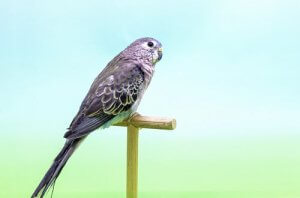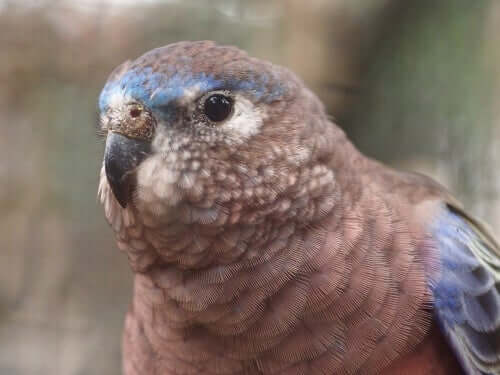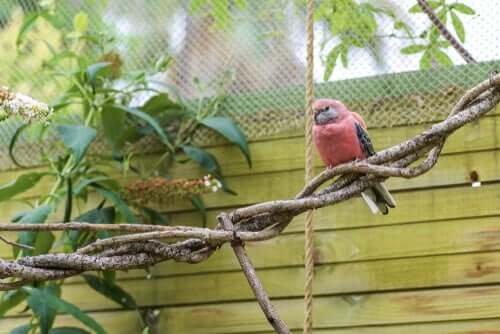The Diet and Habitat of the Bourke's Parakeet


Written and verified by biochemistry Luz Eduviges Thomas-Romero
The Bourke’s parakeet is the jewel of a group of herbivorous birds that come from Australia. It’s a fairly calm bird that can whistle a pleasant song.
These parakeets live in nomadic flocks of up to one thousand birds and prefer areas near some source of water. Their scientific name is Neopsephotus bourkii, and there are no subspecies.
What does Bourke’s parakeet look like?
In comparison with other parrots, the feathers of the Bourke’s parakeet is much more toned down. Its coloring is mainly grayish-brown, but has pale blue feathers on its rump, on the sides of its tail, and on its wings. At the same time, their chests and bellies are pale pink in color.
They also have a prominent white area around their eyes, which gives off the appearance of glasses. Females of this species are similar in appearance but more opaque. By adulthood, males measure between 3 and 4 inches. These birds can live for up to 25 years.

The colors of the Bourke’s parakeet complement its natural habitat. Its plumage helps it to blend in with the reddish earth of its arid home.
Where does the Bourke’s parakeet live?
In its native country of Australia, the Bourke’s parakeet–also known as the Bourkie–inhabits the acacia forests. In these barren and seemingly inhospitable areas, they escape the heat of the day by resting in the shade of the trees. They are most active at sunset and sunrise when they search for pools from which to drink water.
So, it’s easier to spot these birds in deserts and xeric shrublands, rich in native acacias and cypress trees, as well as open woodlands of eucalyptus trees. It’s worth pointing out that little is known about the seasonal movements of these birds. While experts believe them to be nomadic, it’s likely that they’re residents in some areas.
What are the dietary habits of this bird?
Bourkies feed mainly on the ground and only occasionally look for food among the trees. They congregate in pairs or small groups of four or six. Their diet consists of seeds from grass, which they complement with fruits, berries, and insects. They always need to be near a water source, which they generally visit at sunrise and sunset.
In captivity, the diet of the Bourke’s parakeet should consist of granulated food and a parakeet seed mix. They must also receive fruit–such as apples–and leafy greens to make their diet complete.
However, adequate nutrition for any young born in captivity implies more than just seeds. Baby bourkies need a granulated diet, germinated seeds, fruit, other vegetables, and even insects. Birds that are in a reproductive state can eat mealworms in order to get the protein they need.
Diet according to a bird’s stage of development
It’s important to keep in mind that the nutritional requirements of the Bourke’s parakeet vary according to its developmental stage.

It’s important to tend to the specific needs of these birds at every stage of development: As babies, youth, adults, reproductive adults, and–of course–if they’re ill.
Young Bourke’s parakeets
These parakeets form couples. They build their nests in the holes–usually vertical–of trees or some dead tree trunk. As for their eggs, they lay them on a rotten piece of wood at the bottom of the hole.
In this particular species, the females take full responsibility for incubating their eggs. Once a day, they leave their nests to feed on regurgitated seed that their male partners provide for them. Both the female and the male share the task of raising their young.
What type of personality can I expect from my Bourke’s parakeet?
These birds are intelligent but they’re also gentle and quiet–especially in comparison to other parrot species. In captivity, they tend not to fly or climb very much. Just the same, they move about a lot, jumping from one perch to another.
In their natural habitat, they fly early in the morning and, in the evening, sing and interact with their surroundings and with others. Although they aren’t truly nocturnal birds, they are known to be more active after dark. This sets them apart from most other parrots.
It’s important to keep in mind that, given their passive nature, Bourke’s parakeets should stay away from larger and more aggressive birds.
All cited sources were thoroughly reviewed by our team to ensure their quality, reliability, currency, and validity. The bibliography of this article was considered reliable and of academic or scientific accuracy.
- Piñeiro, C. J. S., & Bert, E. (2011). Principios en la alimentación de psitacidas. Revista Electrónica de Veterinaria, 12(11), 1-3.
- Kennedy, J. D. (1993). Raising the Charming Bourke’s Parakeet. AFA Watchbird, 20(5), 30-33.
This text is provided for informational purposes only and does not replace consultation with a professional. If in doubt, consult your specialist.